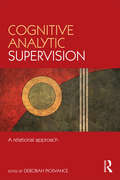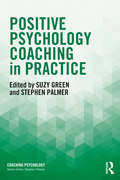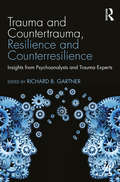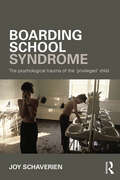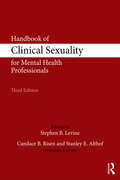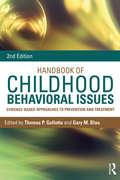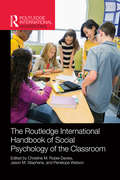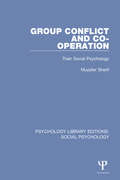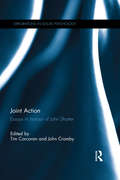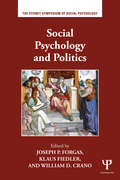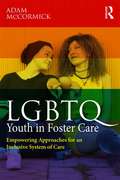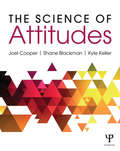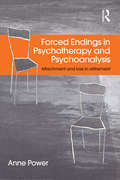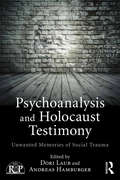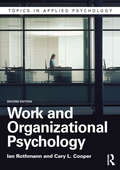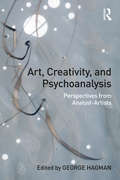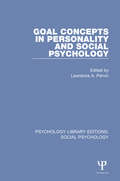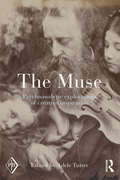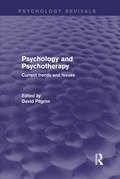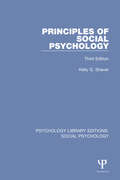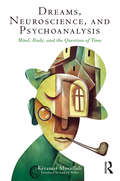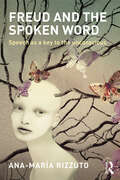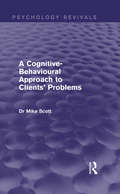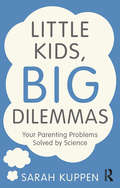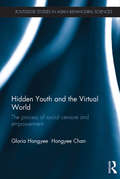- Table View
- List View
Cognitive Analytic Supervision: A relational approach
by Deborah PickvanceCognitive Analytic Supervision: A relational approach is the first book to present a cognitive analytic perspective on psychotherapy supervision. This edited collection of original chapters reflects the ways in which CAT therapists and supervisors have developed the model and used it in diverse settings. It is a significant contribution to the literature on relational psychotherapy supervision, written by established CAT supervisors, trainers and therapists who, together, have an enormous amount of professional and clinical experience. The book covers important areas such as: the relational theory and practice of CAT supervision a cognitive analytic conceptualization of narcissistic difficulties intercultural issues in supervision (based on CAT training experience in India) ethical and clinical dilemmas in supervision supervision of consultancy work Cognitive Analytic Supervision will be of interest to CAT supervisors, therapists and trainee supervisors, as well as supervisors and therapists working in other therapeutic models, in particular those with a relational approach. This book may be a useful bridge into relationally informed supervision for therapists who do not have an explicitly relational focus.
Positive Psychology Coaching in Practice (Coaching Psychology)
by Suzy Green Stephen PalmerPositive Psychology Coaching in Practice provides a comprehensive overview of positive psychology coaching, bringing together the best of science and practice, highlighting current research, and emphasising the applicability of each element to coaching. With an international range of contributors, this book is a unique resource for those seeking to integrate positive psychology into their evidence-based coaching practice. Beginning with an overview of positive psychology coaching, the book includes an assessment of theories of wellbeing, an examination of mindfulness research, a guide to relevant neuroscience, and a review of a strengths-based approach. It also contains chapters which explore the application of ACT, the role of positive psychology in wellness and resilience coaching, positive leadership theory, and developmental psychological theories as they relate to coaching through significant life transitions. In each chapter, theory and research is thoroughly explored and applied directly to coaching practice, and supported with a list of relevant resources and a case study. The book concludes with the editors’ views on the future directions of positive psychology coaching. Positive Psychology Coaching in Practice will be essential reading for professional coaches in practice and in training seeking to enhance their evidence-based practice, coaching psychologists, practitioners of positive psychology, and academics and students of coaching, coaching psychology and positive psychology.
Trauma and Countertrauma, Resilience and Counterresilience: Insights from Psychoanalysts and Trauma Experts (Psychoanalysis in a New Key Book Series)
by Richard GartnerTreating traumatized patients takes its toll on the treating clinician, giving rise over time to what Richard B. Gartner terms countertrauma in the psychoanalyst or therapist. Paradoxically, a clinician may also be imbued with a sense of optimism, or counterresilience, after learning how often the human spirit can triumph over heartbreakingly tragic experiences. Trauma and Countertrauma, Resilience and Counterresilience brings together a distinguished group of seasoned clinicians, both trauma specialists and psychoanalysts. Their personal reflections show what clinicians all too rarely dare to reveal: their personal traumatic material. They then discuss how they develop models for acknowledging, articulating, and synthesizing the countertrauma that arises from long-term exposure to patients’ often-harrowing trauma. Writing openly, using viscerally affecting language, the contributors to this exceptional collection share subjective and sometimes intimate material, shedding light on the inner lives of people who work to heal the wounds of psychic trauma. By the same token, many of these clinicians describe how working intimately with traumatized individuals can affect the listener positively, recounting how patients’ resilience evokes counterresilience in the therapist, allowing the clinician to benefit from ongoing contact with patients who deal bravely with horrific adversity. Paradoxically, a clinician may be imbued with a sense of optimism after learning how often the human spirit can triumph over heartbreakingly tragic experiences. Trauma and Countertrauma, Resilience and Counterresilience will appeal to psychoanalysts, psychoanalytic psychotherapists, and trauma experts, offering a valuable resource to those beginning their careers in mental health work, to teachers and supervisors of trauma therapists, to experienced clinicians struggling with burnout, and to anyone who wants to understand the psychotherapeutic process or indeed the human condition.
Boarding School Syndrome: The psychological trauma of the 'privileged' child
by Joy SchaverienBoarding School Syndrome is an analysis of the trauma of the 'privileged' child sent to boarding school at a young age. Innovative and challenging, Joy Schaverien offers a psychological analysis of the long-established British and colonial preparatory and public boarding school tradition. Richly illustrated with pictures and the narratives of adult ex-boarders in psychotherapy, the book demonstrates how some forms of enduring distress in adult life may be traced back to the early losses of home and family. Developed from clinical research and informed by attachment and child development theories ‘Boarding School Syndrome’ is a new term that offers a theoretical framework on which the psychotherapeutic treatment of ex-boarders may build. Divided into four parts, History: In the Name of Privilege; Exile and Healing; Broken Attachments: A Hidden Trauma, and The Boarding School Body, the book includes vivid case studies of ex-boarders in psychotherapy. Their accounts reveal details of the suffering endured: loss, bereavement and captivity are sometimes compounded by physical, sexual and psychological abuse. Here, Joy Schaverien shows how many boarders adopt unconscious coping strategies including dissociative amnesia resulting in a psychological split between the 'home self' and the 'boarding school self'. This pattern may continue into adult life, causing difficulties in intimate relationships, generalized depression and separation anxiety amongst other forms of psychological distress. Boarding School Syndrome demonstrates how boarding school may damage those it is meant to be a reward and discusses the wider implications of this tradition. It will be essential reading for psychoanalysts, Jungian analysts, psychotherapists, art psychotherapists, counsellors and others interested in the psychological, cultural and international legacy of this tradition including ex-boarders and their partners.
Handbook of Clinical Sexuality for Mental Health Professionals (500 Tips Ser.)
by Candace B. Risen Stanley E. Althof Stephen B. LevineThe Handbook of Clinical Sexuality for Mental Health Professionals, 3rd Edition, builds on the authors’ authoritative first person voice on sexual matters of the previous editions. The work reflects the field's growing sophistication about sexual disorders and their therapies. The scope has been expanded to keep pace with new literature and research in the field, and eight additional chapters have been added. New topics include the politics of diagnosis, persistent genital arousal, asexuality, post orgasm illness, scientific findings concerning origin of orientation, and partnering with the pharmaceutical industry. Easily accessible, the Handbook is divided into sections that touch on fundamental knowledge and skills; treatment; men’s major sexual concerns; women’s major sexual concerns; problems common to both genders; the diversity of sexual lives; and future and trending topics. Written in a personal, supervisory style, the book will help new therapists anticipate clinical contingencies and help experienced therapists refine their thinking and teaching.
Handbook of Childhood Behavioral Issues: Evidence-Based Approaches to Prevention and Treatment
by Thomas P. Gullotta Gary M. BlauThis handbook highlights present-day information and evidence-based knowledge in the field of children’s behavioral health to enable practitioners, families, and others to choose and implement one of many intervention approaches provided. Using a standardized format, best practices for the prevention and treatment of many childhood behavioral disorders are identified based on current research, sound theory, and behavioral trial studies. This revision includes an integration of the DSM-5 diagnostic manual and new chapters on childhood psychosis and military families, and a thorough updating of the research in the previous edition.
Routledge International Handbook of Social Psychology of the Classroom (Routledge International Handbooks)
by Christine M. Rubie-Davies Jason M. Stephens Penelope WatsonThe Routledge International Handbook of Social Psychology of the Classroom presents the first comprehensive and integrated compilation of theory and research on topics related to the social cohesion of the classroom. Many of these topics have been studied independently; for example, motivation, self-concept, class management, class climate, and teacher expectations are generally studied separately by different groups of researchers. This handbook brings the evidence from different fields in social psychological classroom research together in one place for the first time to explore how these topics relate and how each factor influences students and their learning. With chapters by established international leaders in their fields, as well as emerging new talent, this handbook offers cutting edge research and surveys the state of the art in the social psychology of the classroom. Major areas covered include: Motivation Belief, self-concept, and personality Emotional engagement Teacher–student relationships Teacher expectation Classroom management Culture and identity The Routledge International Handbook of Social Psychology of the Classroom provides a review of current theories related to the social psychology of the classroom, including how these theories apply to classrooms and learners. Current evidence clearly shows that areas explored by social psychology – and brought together for the first time in this volume – can have a very significant impact on classroom learning and student achievement (J. Hattie, Visible Learning: A Synthesis of over 800 Meta-Analyses Relating to Achievement, Routledge 2009). This handbook is a must for all academics whose research relates to the social psychology of the classroom. It is also an invaluable resource for teachers and teacher education students who want to understand why they are effective instructors and yet still encounter students in their classes who are not responding as expected.
Group Conflict and Co-operation: Their Social Psychology (Psychology Library Editions: Social Psychology)
by Muzafer SherifOriginally published in 1966 the author challenges the accepted theories of group conflict of the time, such as frustration and maladjustment. For him conflict and its accompanying aggressiveness are features of interaction between groups and he supports this theory with a detailed experimental study of controlled groups. At the time of publication, Dr Otto Klineberg, Director of the International Centre for Intergroup Relations at the Sorbonne wrote: ‘Social scientists everywhere owe a great debt of gratitude to Professor Sherif. The distinguished series of publications for which he and his co-workers are responsible have an honoured place in our libraries. In particular, his contributions to the field of intergroup relations are outstanding; his concept of "superordinate goals", based on a combination of theoretical insight and brilliant experimentation, has become a household word for those concerned with this significant problem. In his new volume, Group Conflict and Co-operation, he carries his analysis much further, not only describing the results of several original investigations, but also building a theoretical appraisal of an extensive research literature. The author has made still another significant contribution toward a better understanding of one of the most complex and disturbing phenomena of our time.’
Joint Action: Essays in honour of John Shotter (Explorations in Social Psychology)
by Tim Corcoran John CrombyJoint Action: Essays in honour of John Shotter brings together a cross-disciplinary group of fifteen respected international scholars to explain the relevance of John Shotter’s work to emerging concerns in twenty-first century social science. Shotter’s work extends over forty years and continues to challenge conventional scientific thinking across a range of topics. The disciplines and practices that Shotter’s work has informed are well established throughout the English-speaking world. This is the first publication to examine the importance of his influence in contemporary social sciences and it includes authoritative discussions on topics such as social constructionism, democratic practice, organisational change, the affective turn and human relations. The geographical diversity and disciplinary breadth of scholarly contributions imbues the book with international scope and reach. Joint Action presents a contemporary reflection on Shotter’s work that demonstrates its influence across a range of substantive topics and practical endeavours and within disciplines including management studies and philosophy as well as psychology. As such, it will appeal to researchers and postgraduate students of social sciences and related disciplines, as well as to those who have heard of Shotter’s work and want to know more about its utility and value in relation to their own research or practice.
Social Psychology and Politics: Narrative And Metaphor In Politics (Sydney Symposium of Social Psychology)
by Joseph P. Forgas Klaus Fiedler William D. CranoSocial psychology and politics are intricately related, and understanding how humans manage power and govern themselves is one of the key issues in psychology. This volume surveys the latest theoretical and empirical work on the social psychology of politics, featuring cutting-edge research from a stellar group of international researchers. It is organized into four main sections that deal with political attitudes and values; political communication and perceptions; social cognitive processes in political decisions; and the politics of intergroup behavior and social identity. The contributions address such exciting questions as how do political attitudes and values develop and change? What role do emotions and moral values play in political behavior? How do political messages and the media influence political perceptions? What are the psychological requirements of effective democratic decision making, and why do democracies sometimes fail? How can intergroup harmony be developed, and what is the role of social identity in political processes? As such, this volume integrates the role of cognitive, affective, social and cultural influences on political perception and behavior, offering an overview of the psychological mechanisms underlying political processes. It provides essential reading for teachers, students, researchers and practitioners in areas related to power, social influence and political behavior.
LGBTQ Youth in Foster Care: Empowering Approaches for an Inclusive System of Care
by Adam McCormickRepresenting an often overlooked population in social work literature, this book explores the experiences of LGBTQ youth as they navigate the child welfare system. Adam McCormick examines the entirety of a youth’s experience, from referral into care and challenges to obtaining permanency to aging out or leaving care. Included throughout the book are stories from LGBTQ youth that address personal issues such as abuse, bullying and harassment, and double standards. Filled with resources to foster resilience and empower youth, this book is ideal for professionals who are hoping to create a more inclusive and affirming system of care for LGBTQ youth.
The Science of Attitudes
by Joel Cooper Kyle Keller Shane BlackmanThe Science of Attitudes is the first book to integrate classic and modern research in the field of attitudes at a scholarly level. Designed primarily for advanced undergraduates and graduate students, the presentation of research will also be useful for current scholars in all disciplines who are interested in how attitudes are formed and changed. The treatment of attitudes is both thorough and unique, taking a historical approach while simultaneously highlighting contemporary views and controversies. The book traces attitudes research from the inception of scientific study following World War II to the issues and methods of research that are prominent features of today's research. Researchers in the field of attitudes will be particularly interested in classic and modern research on the organization, structure, strength and function of attitudes. Researchers in the field of persuasion will be particularly interested in work on attitude change focusing on propositional and associative learning, metacognition and dynamic theories of dissonance, balance and reactance. The book is designed to present the integration of the properties of the attitude with the dynamic considerations of attitude change. The Science of Attitudes is also the first book on attitudes to devote entire chapters to work on implicit measurements, resistance to persuasion, and social neuroscience.
Forced Endings in Psychotherapy and Psychoanalysis: Attachment and loss in retirement
by Anne PowerForced Endings in Psychotherapy and Psychoanalysis: Attachment and Loss in Retirement explores the ambivalence the therapist may feel about letting go of a professional role which has sustained them. Anne Power explores the process of closing a private practice, from the first ethical decision-making, through to the last day when the door of the therapy room shuts. She draws on the personal accounts of retired therapists and others who had to impose an ending on clients due to illness, in order to move house, to take maternity leave or a sabbatical. A forced ending is an intrusion of the clinician’s own needs into the therapeutic space. Anne Power shows how this might compromise the work but may also be an opportunity for deeper engagement. Drawing on attachment theory to understand how the therapeutic couple cope with an imposed separation, Power includes interviews with therapists who took a temporary break to demonstrate the commonality of challenges faced by those who need to impose an ending on clients. Forced Endings in Psychotherapy and Psychoanalysis opens up an area which has been considered taboo in the profession so that future cohorts can benefit from the reflections and insights of this earlier generation. It will support clinicians making this transition and aims to support ethical practice so that clients are not exposed to unnecessary risks of the sudden termination of a long treatment. This book will be essential reading for practicing psychotherapists and psychoanalysts, and to undergraduate and post-graduate students in clinical psychology, psychiatry and social work
Psychoanalysis and Holocaust Testimony: Unwanted Memories of Social Trauma (Relational Perspectives Book Series)
by Andreas Hamburger Dori LaubPsychoanalytic work with socially traumatised patients is an increasingly popular vocation, but remains extremely demanding and little covered in the literature. In Psychoanalysis and Holocaust Testimony, a range of contributors draw upon their own clinical work, and on research findings from work with seriously disturbed Holocaust survivors, to illuminate how best to conduct clinical work with such patients in order to maximise the chances of a positive outcome, and to reflect transferred trauma for the clinician. Psychoanalysis and Holocaust Testimony closely examines the phenomenology of destruction inherent in the discourse of extreme traumatization, focusing on a particular case study: the recording of video testimonies from a group of extremely traumatized, chronically hospitalized Holocaust survivors in psychiatric institutions in Israel. This case study demonstrates how society reacts to unwanted memories, in media, history, and psychoanalysis – but it also shows how psychotherapists and researchers try to approach the buried memories of the survivors, through being receptive to shattered life narratives. Questions of bearing witness, testimony, the role of denial, and the impact of traumatic narrative on society and subsequent generations are explored. A central thread of this book is the unconscious countertransference resistance to the trauma discourse, which manifests itself in arenas that are widely apart, such as genocide denial, the "disappearance" of the hospitalized Holocaust survivors and of their life stories, mishearing their testimonies and ultimately refusing them the diagnosis of "traumatic psychosis". Psychoanalysis and Holocaust Testimony provides an essential, multidisciplinary guide to working psychoanalytically with severely traumatised patients. It will appeal to psychoanalysts, psychoanalytic psychotherapists and trauma studies therapists.
Work and Organizational Psychology
by Ian Rothmann Cary L. CooperPsychologists have been fascinated by the world of work, and the changing relationship between people, technology and the workplace, since the onset of the industrial revolution. And in providing a complete and contemporary overview of this evolving and fascinating field, the new edition of Work and Organizational Psychology is the perfect textbook, outlining not only the key theoretical ideas, but also how they relate to the role of psychologists advising today’s organizations. The only textbook to integrate the fields of HRM and organizational behaviour, the new edition is thoroughly revised to cover new technological advances such as virtual workplaces and virtual employees. In an era of rapid socio-economic change, there is also expanded coverage of the role of workplace diversity, employee commitment and globalization, as well as updated chapters on key concepts such as motivation, leadership, group behaviour and well-being at work. Also including a chapter on career development, the book is supported by a range of pedagogical features, spotlighting issues of theoretical, ethical or contemporary interest, whilst also enabling students to engage in active learning. Lucid and comprehensive, the second edition of Work and Organizational Psychology will be the cornerstone for any student of this dynamic field.
Art, Creativity, and Psychoanalysis: Perspectives from Analyst-Artists
by George HagmanArt, Creativity, and Psychoanalysis: Perspectives from Analyst-Artists collects personal reflections by therapists who are also professional artists. It explores the relationship between art and analysis through accounts by practitioners who identify themselves as dual-profession artists and analysts. The book illustrates the numerous areas where analysis and art share common characteristics using first-hand, in-depth accounts. These vivid reports from the frontier of art and psychoanalysis shed light on the day-to-day struggle to succeed at both of these demanding professions. From the beginning of psychoanalysis, many have made comparisons between analysis and art. Recently there has been increasing interest in the relationship between artistic and psychotherapeutic practices. Most important, both professions are viewed as highly creative with spontaneity, improvisation and aesthetic experience seeming to be common to each. However, differences have also been recognized, especially regarding the differing goals of each profession: art leading to the creation of an art work, and psychoanalysis resulting in the increased welfare and happiness of the patient. These issues are addressed head-on in Art, Creativity, and Psychoanalysis: Perspectives from Analyst-Artists. The chapters consist of personal essays by analyst/artists who are currently working in both professions; each has been trained in and is currently practicing psychoanalysis or psychoanalytic psychotherapy. The goal of the book is to provide the audience with a new understanding of psychoanalytic and psychotherapeutic processes from the perspective of art and artistic creativity. Drawing on artistic material from painting, poetry, photography, music and literature, the book casts light on what the creative processes in art can add to the psychoanalytic endeavor, and vice versa. Art, Creativity, and Psychoanalysis: Perspectives from Analyst-Artists will appeal to psychoanalysts and psychoanalytic psychotherapists, theorists of art, academic artists, and anyone interested in the psychology of art.
Goal Concepts in Personality and Social Psychology (Psychology Library Editions: Social Psychology)
by Lawrence A. PervinIs behavior motivated? And if so, can it be motivated by the anticipation of future events? What role does cognition play in such motivational processes? And, further, what role does motivation play in ongoing cognitive activity? Questions such as these provide the foundation for this book, originally published in 1989. More specifically, the chapters in this book address the question of the utility of goals concepts in studying motivation and social cognition.
The Muse: Psychoanalytic Explorations of Creative Inspiration (Psychoanalytic Inquiry Book Series)
by Adele TutterPsychoanalysts have long been fascinated with creative artists, but have paid far less attention to the men and women who motivate, stimulate, and captivate them. The Muse counters this trend with nine original contributions from distinguished psychoanalysts, art historians, and literary scholars—one for each of the nine muses of classical mythology—that explore the muses of disparate artists, from Nicholas Poussin to Alison Bechdel. The Muse breaks new ground, pushing the traditional conceptualization of muses by considering the roles of spouse, friend, rival, patron, therapist—even a late psychoanalytic theorist—in facilitating creativity. Moreover, they do so not only by providing inspiration, but also by offering the artist needed material and emotional support; tolerating competitive aggression; promoting reflection and insight; and eliciting awe, anxiety and gratitude. Integrating art history and literary criticism with a wide spectrum of contemporary psychoanalytic perspectives, The Muse is essential reading for psychoanalysts and psychotherapists interested in the relationships that enhance and support creative work. Fully interdisciplinary, it is also accessible to readers in the fields of art, art history, literature, memoir, and film. The Muse sheds new light on that most mysterious dyad, the artist and muse—and thus on the creative process itself.
Psychology and Psychotherapy: Current Trends and Issues (Psychology Revivals)
by David PilgrimOriginally published in 1983, fifteen well-known psychologists and psychotherapists write about their personal interests to give the reader a vivid picture of the complexities of psychotherapy in Britain at the time. They explore aspects of the interaction and intersection of the psychological and psychotherapeutic worlds, paying particular attention to the practical and theoretical controversies involved in this overlap. The first half of the book concerns itself with problems of theory and practice in psychology and psychotherapy, while the second half deals with professional conflicts and political issues impinging upon the practice of psychotherapy by psychologists. Areas of concern and controversy that are scrutinised include the problematic relationship between academic psychology and psychotherapy; doubts and certainties in psychotherapy; the psychology of helping; the relevance of the psychodynamic tradition; inter-professional disputes; women and psychotherapy; and social class issues in psychotherapy.
Principles of Social Psychology: Third Edition (Psychology Library Editions: Social Psychology)
by Kelly G. ShaverOriginally published in 1987 this third edition won praise from students and instructors alike for its challenging "no nonsense" approach to the field. Thoroughly updated to reflect current research of the time, the text retains the qualities that had become its hallmarks: a cognitive approach to the process of socialization, and an emphasis on the ideas that give the discipline continuity. It offers clear, conceptually integrated discussions of all of the major topics in social psychology from the time. Shaver's focus on the concepts of social psychology provides a framework for students to develop their own applications. The principles of social behavior are presented in the text in the same way they develop in the individual moving from internal processes (social perception, self-recognition) to external issues (the environment, the law) that influence behavior. Shaver weaves contemporary issues into his treatment of basic theories, using examples from everyday situations. His supple writing engages students in the complexity of social behavior, and is one reason this title remained one of the most highly regarded texts in the field at the time.
Dreams, Neuroscience, and Psychoanalysis: Mind, Body, and the Question of Time
by Keramat MovallaliDreams, Neuroscience, and Psychoanalysis sets out to give a scientific consistency to the question of time and find out how time determines brain functioning. Neurological investigations into dreams and sleep since the mid-20th century have challenged our scientific conception of living beings. On this basis, Kéramat Movallali reviews the foundations of modern neurophysiology in the light of other trends in this field that have been neglected by the cognitive sciences, trends that seem to be increasingly confirmed by recent research. ? The author begins by giving a historical view of fundamental questions such as the nature of the living being according to discoveries in ethology as well as in other research, especially that which is based on the theory of the reflex. It becomes clear in the process that these findings are consistent with the question of time as it has been considered in some major contemporary philosophies. This is then extended to the domain of dreams and sleep, as phenomena that are said to be elucidated by the question of time.? The question is then raised: can dreaming be considered as a drive? Based on the Freudian discovery of the unconscious and Lacan’s teachings, Movallali seeks to provide a better understanding of the drives in general and dreams in particular. He explores neuroscience in terms of its development as well as its discoveries in the function of dreaming as an altered mode of consciousness. The challenge of confronting psychoanalysis with neuroscience forces us to go beyond their division and opposition. Psychoanalysis cannot overlook what has now become a worldwide scientific approach. Neuroscience, just like the cognitive sciences, will be further advanced by acknowledging the desiring dimension of humanity, which is at the very heart of its being as essentially related to the question of time. It is precisely this dimension that is at the core of psychoanalytic practice.? Dreams, Neuroscience, and Psychoanalysis will appeal to psychoanalysts and psychoanalytic psychotherapists as well as neuroscientists, psychologists, ethologists, philosophers and advanced students studying across these fields.
Freud and the Spoken Word: Speech as a key to the unconscious
by Ana-Maria RizzutoThere is extensive literature on Freud and language; however, there is very little that looks at Freud’s use of the spoken word. In Freud and the Spoken Word: Speech as a key to the unconscious, Ana-María Rizzuto contends that Freud’s focus on the intrapsychic function and meaning of patients’ words allowed him to use the new psychoanalytic method of talking to gain access to unconscious psychic life. In creating the first ‘talking therapy’, Freud began a movement that still underpins how psychoanalysts understand and use the spoken word in clinical treatment and advance psychoanalytic theory. With careful and critical reference to Freud’s own work, this book draws out conclusions on the nature of verbal exchanges between analyst and patient. Ana- María Rizzuto begins with a close look at Freud’s early monograph On Aphasia, suggesting that Freud was motivated by his need to understand the disturbed speech phenomena observed in three of the patients described in Studies on Hysteria. She then turns to an examination of how Freud integrated the spoken word into his theories as well as how he actually talked with his patients, looking again at the Studies in Hysteria and continuing with the Dora case, the Rat Man and the Wolf Man. In these chapters, the author interprets how Freud’s report of his own words shed light on the varying relationships he had with his patients, when and how he was able to follow his own recommendations for treatment and when another factor (therapeutic zeal, or the wish to prove a theory) appeared to interfere in communication between the two parties in the analysis. Freud and the Spoken Word examines Freud’s work with a critical eye. The book explores his contribution in relation to the spoken word, enhances its significance, and challenges its shortcomings. It is written for psychoanalysts, psychotherapists, Freud’s scholars and academics interested in his views on the words spoken in life and in psychoanalysis. Argentine born Ana-María Rizzuto trained in psychoanalysis in Boston and was for forty years in the PINE Psychoanalytic Center Faculty and is Training and Supervisory Analyst Emerita. She has made significant contributions to the psychoanalysis of religious experience and has written in national and international journals about the significance of words in the clinical situation. She has written three books and lectured about her work in North America, Latin America, Europe, and Japan.
A Cognitive-Behavioural Approach to Clients' Problems (Psychology Revivals)
by Michael J. ScottThe most useful therapy is one that can be applied to a wide range of client problems, is easy to learn, and produces lasting results following a brief intervention. The cognitive-behavioural approaches described in this volume probably come nearest to this ideal. Originally published in 1989, this book begins with a description of the cognitive-behavioural revolution that had taken place in the decade prior to publication and provides therapists with the specifics of helping in four major areas: child behaviour problems, emotional disorders (depression and anxiety), interpersonal problems and addictive disorders. Coverage of the major areas of concern begins in each case with an overview of theory and research in the specific domain, followed by detailed guidance for practice. The volume represents a synthesis of the author’s research and practice with patients in inner city Liverpool and with employees referred by major employers. The strategies described have been devised to take account of a wide variety of client social contexts and service delivery settings, and the strengths, pitfalls and practicalities of group cognitive-behavioural approaches are also discussed. The reader is finally led into largely uncharted waters, the application of cognitive-behavioural approaches to schizophrenia, people with learning difficulties and the elderly. Back in print, this title will still be of interest to students and practitioners in social work, clinical psychology, and community psychiatry.
Little Kids, Big Dilemmas: Your parenting problems solved by science
by Sarah KuppenFed up with conflicting advice? This book offers real answers to the following questions and more… Can sleep training harm my baby? Is screen time bad for my child? Is breast always best? Psychologist Dr Sarah Kuppen, expert in early child development, uses her scientific expertise to sort through the hype and give you the facts. Using the latest developmental research, she provides practical tips and solves more than 50 familiar parent questions and dilemmas. Inside you will find advice on: • five ways to tame a tantrum • what to do if your child isn’t talking • the scientific facts on breast versus formula feeding • managing sibling fights and conflict. Little Kids, Big Dilemmas is an essential guide for science-minded parents and childcare professionals alike. Reading this book will allow you to make informed decisions on the big topics for parenting in the early years.
Hidden Youth and the Virtual World: The process of social censure and empowerment (Routledge Studies in Asian Behavioural Sciences)
by Gloria Hongyee ChanHidden Youth and the Virtual World examines the phenomenon of ‘hidden youth’ or hikikomori, as it is better known in Japan as well as Hong Kong. Exposure to the Internet has allowed these young persons to develop a high level of capability within the virtual world, however these are skills that are not highly valued by society. This book uncovers the truth about hidden youth, the causes, coping strategies, power relations between them and adults in society, and their relationship with the virtual world. Key topics surrounding the phenomenon of hidden youth are explored in detail, including: The framework of Social Censure Theory The theoretical concepts of hegemony and the impact that labelling by the Government, the media and institutions has had on hidden youth The willingness of the hidden youth to remain hidden within the virtual world Subcultures as a platform for hidden youth empowerment This is a particularly useful volume to researchers in child and adolescent psychology, clinical psychology, counselling and psychotherapy, school psychology, sociology, social work, and youth policy; as well as youth workers, school counsellors and mental health professionals, and will appeal to the interest of both academics and practitioners alike.
